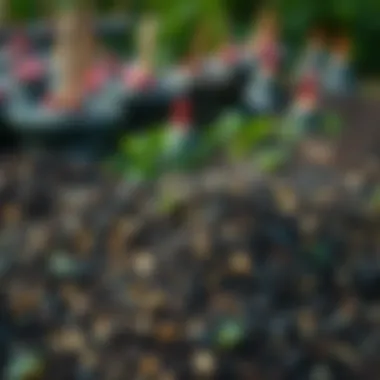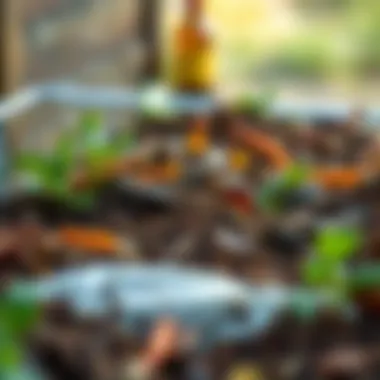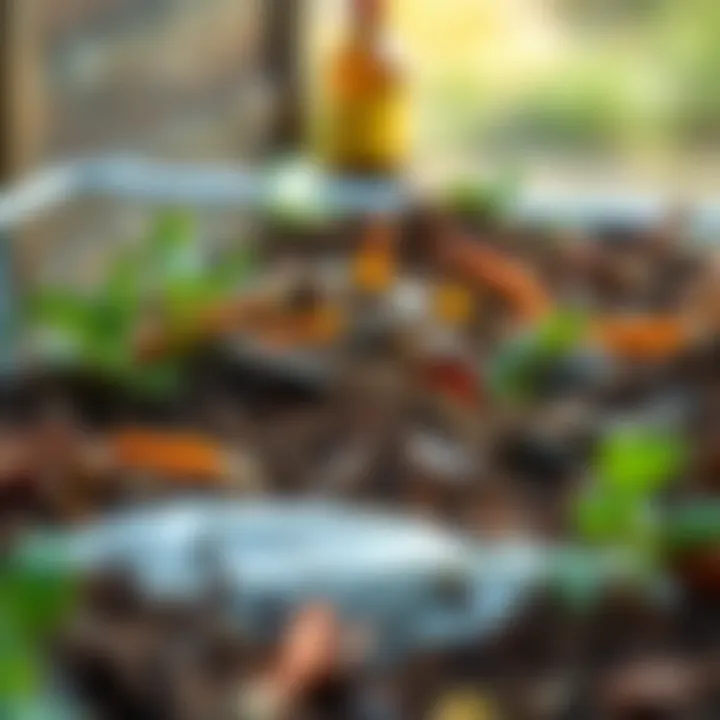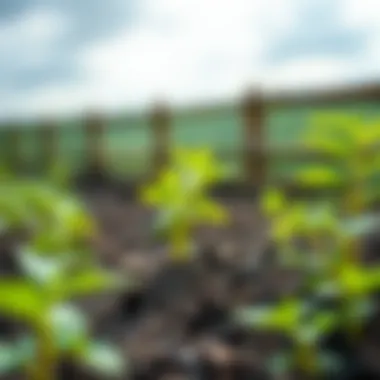Deep Dive into Small Farm Composting Systems


Intro
Small farms present unique opportunities and challenges, especially when it comes to managing organic waste effectively. Composting serves as an essential practice not only for enhancing soil health but also for promoting sustainability within these mini-ecosystems. Understanding the art and science of composting can lead to improved crop yields, reduced reliance on chemical fertilizers, and a healthier environment.
This guide will walk through the various aspects of small farm composting systems, providing valuable insights for agricultural enthusiasts and practitioners alike. Each section is designed to equip you with the knowledge necessary to foster your composting journey, whether you're just starting out or looking to refine your existing practices.
You’ll find discussions on the benefits of composting, methods suitable for small-scale operations, and the ingredients required to create nutrient-rich compost. We'll also cover common pitfalls and ways to overcome them through practical case studies. Whether you are attempting to reduce waste, enhance soil quality, or promote more sustainable farming practices, this overview stands to be an essential resource.
Intro to Small Farm Composting Systems
Composting has become a cornerstone of sustainable agricultural practices, especially on small farms. It's a natural process of recycling organic matter, transforming kitchen scraps, yard waste, and other biodegradable materials into nutrient-rich compost. This introduction delves into the essence of small farm composting systems, emphasizing their significance in modern agriculture for enhancing soil health and promoting efficient waste management.
At the heart of this discussion lies the definition and purpose of composting systems. Understanding what composting is and why it matters is crucial for any farmer aiming to improve their land and produce healthier crops. Composting not only enriches the soil but also helps in reducing the volume of waste that would otherwise be landfilled, aligning closely with the principles of ecological stewardship.
Moreover, there’s a historical context here that paints a vivid picture of how composting has evolved. Historically, farmers have relied on organic composting practices, often utilizing animal manures and crop residues to bolster soil quality. These time-tested methods, rooted in traditions passed down through generations, have transitioned into modern farming techniques that embrace science and technology. By exploring these foundations, we see that the practice of composting is not merely a contemporary fad; rather, it is deeply embedded in agricultural history and culture, celebrated for its effectiveness and sustainability.
In summary, the relevance of small farm composting systems can’t be overstated. They are a vital strategy for improving soil fertility, decreasing waste, and making agricultural practices more sustainable. As we move forward in this article, we’ll explore various aspects of composting systems that can aid small farmers, offering insights that are not just theoretical but practical for real-world application.
Benefits of Composting on Small Farms
Composting is not just a way to get rid of kitchen scraps; it’s a keystone method that can significantly enhance the functionality and sustainability of small farm operations. By transforming organic waste into nutrient-rich compost, farmers can enjoy multiple benefits that extend beyond soil improvement. First and foremost, composting contributes to soil health, but it also plays a vital role in reducing waste and caring for the environment. Let's delve into these advantages more deeply.
Soil Fertility Improvement
Improving soil fertility is a primary reason many small farmers turn to composting. Compost is teeming with microorganisms that break down organic materials, helping to replenish the soil with essential nutrients. Here’s how it works: when you incorporate compost into the soil, you're not just adding bulk but enriching it with nitrogen, phosphorus, potassium, and other trace minerals necessary for plant growth. This rich mixture enhances soil structure, enabling better water retention and aeration, which benefits root development.
"Healthy soil leads to healthy plants, and healthy plants grow healthy food."
A study by the USDA (https://www.usda.gov) highlights that farms using compost experience increased crop yields. With the introduction of compost, nutrient runoff is reduced, maintaining a balance in the ecosystem. Moreover, the microorganisms present in compost not only help crops absorb nutrients more efficiently but can also outcompete harmful pathogens, reducing disease incidence in healthy plants.
Waste Reduction Strategies
One of the hidden gems of composting is its ability to dramatically cut down on waste. Every year, millions of tons of organic matter are tossed into landfills, contributing to pollution and greenhouse gas emissions. By opting for composting, small farmers can turn kitchen scraps, spoiled produce, and even animal waste into a resource rather than trash.
These methods lead to effective waste management:
- On-site composting: Reduces disposal costs and keeps the nutrient cycle local. Farmers can use backyard compost bins or trench composting, depending on their scale.
- Community-driven programs: Farmers can participate in local waste collection initiatives where they convert community food scraps into compost.
By viewing waste as a valuable resource, farmers not only increase the sustainability of their practices but also enhance local ecosystems.
Environmental Advantages
When it comes to environmental stewardship, composting is a champion. Utilizing compost reduces reliance on chemical fertilizers, whose runoffs can harm water bodies and disrupt local biodiversity. With compost, farmers are actively participating in mitigating the negative effects of conventional agriculture.
Furthermore, composting helps sequester carbon in the soil, contributing to climate change solutions. Studies show that increasing soil organic matter through compost can dramatically enhance the soil's ability to store carbon. Additionally, this process supports soil biodiversity.
- Improved air quality: Healthy soils foster healthier plants, which contribute to cleaner air.
- Fauna support: Practices like vermicomposting create habitats for beneficial earthworms and other soil organisms, enhancing ecosystem function.
In summary, the benefits of composting on small farms are multifaceted, extending from soil health to community wellness and preserving the broader environment. The adoption of composting is far more than a trend; it is foundational to sustainable farming practices that prioritize health for the land, the crops, and the communities they nourish.
Types of Composting Systems for Small Farms
When it comes to small farm composting, choosing the right system is fundamental. Not only does it influence the efficiency of compost production, but it also affects how well the resulting compost can nourish your soil and plants. Each type of composting system comes with its own set of benefits, challenges, and considerations. Knowing these can help small-scale farmers make a more informed choice, aligning with their land size, available materials, and goals.
Backyard Compost Bins
Backyard compost bins are the classic image of composting, and for good reason. They are typically straightforward to set up and can be constructed from various materials like wood or wire mesh. Backyard bins are manageable in size, making them ideal for small farms, and they allow for efficient decomposition of kitchen scraps, garden waste, and other organic materials.
In a backyard setup, the heat generated during decomposition attracts beneficial microorganisms while also controlling moisture levels—key elements in breaking down organic waste effectively. It's practical and environmentally friendly, making it a community-friendly choice too. On the downside, if not maintained properly, these bins can become breeding grounds for pests or generate unpleasant odors. Still, when done right, they can yield rich compost in a matter of months.
Vermicomposting Systems
For those seeking an alternative method, vermicomposting stands out. Utilizing worms—particularly red wigglers—this system breaks down organic matter with astounding efficiency. Worms accelerate the composting process by consuming food scraps and producing nutrient-rich castings (worm poop) that are packed with beneficial microbes.
The primary benefit? It's compact and can be done indoors or outdoors, making it a fit for small spaces. Plus, worm composting is a fascinating endeavor, perfect for anyone looking to engage with nature on a deeper level. However, one should be mindful of the worms’ needs, such as moisture and temperature requirements. If conditions are not right, it can lead to worms escaping or even dying.
Trench Composting
Trench composting is another fascinating method to consider. Instead of a traditional bin, this system involves digging a trench in a garden bed and layering it with organic materials. It's a particularly easy way to compost large amounts of waste without requiring extra equipment. Nutrients leach into the surrounding soil, enriching the garden bed while also decreasing space taken up by compost piles above ground.
This method is especially valuable for no-till farming practices and can improve soil structure and fertility, directly benefiting your crops. Still, trench composting takes time to fully integrate, and it's less effective during winter since decomposition slows down considerably. But for those who can plan around seasonal changes, it's an invaluable method.
Composting Tumblers
Composting tumblers offer an innovative approach to composting for small farms. These contained units allow for easy mixing of materials, which ensures they break down evenly and fast. Tumblers can be more organized and cleaner than traditional pile systems, making them a popular choice for urban or suburban farmers.
They are relatively straightforward to use: just fill, turn, and wait. However, it’s important to monitor the moisture levels, since a tumbler can easily dry out if neglected. A significant advantage lies in their speed; well-managed tumblers can produce compost in as little as a month. Regardless of their convenience, they do require a level of investment, which may not be feasible for every small-scale farmer.


"Choosing the right composting system is crucial. It’s not just about the method you go for; it’s about how well it fits into your lifestyle and farming practices."
Each method has its unique perks, but the right choice ultimately depends on the specific needs and conditions of your farm. It is essential to evaluate how much space you have, what materials you can gather, and even how much time you want to invest.
For more detailed information on different composting methods, visit Wikipedia on Composting. It outlines many of the techniques and their alignment with sustainable practices, relevant for anyone interested in small farm composting.
Essential Components of Composting
To create a successful composting system on a small farm, understanding the essential components is crucial. These elements work together to transform organic waste into nutrient-dense compost that can significantly enhance soil quality. The process may seem simple, but the interplay between the various components determines the efficiency and quality of the compost produced. Therefore, recognizing the importance of carbon-to-nitrogen ratios, moisture control, and aeration techniques can help farmers avoid common pitfalls and craft a robust compost recipe.
Carbon and Nitrogen Ratios
Getting the right balance of carbon and nitrogen is at the heart of effective composting. These two key ingredients are often referred to as the "C:N ratio." Carbon-rich materials, known as browns, include things like shredded cardboard, dried leaves, and straw. They serve as energy sources for microbes. On the flip side, nitrogen-rich materials, or greens, encompass fresh grass clippings, vegetable scraps, and manure, which provide proteins for decomposer organisms.
The ideal carbon-to-nitrogen ratio typically hovers around 30:1; this means for every 30 parts of carbon, there's one part of nitrogen. Achieving this balance is not just about numbers, it's also about understanding how the materials you use will interact during decomposition. For practical composting, keep in mind these simple steps:
- Collect materials: Gather a mix of browns and greens, ensuring you have enough of both.
- Layer wisely: Start with a layer of browns at the bottom, then add greens, continuing to alternate layers.
- Monitor and adjust: If you notice a foul smell, it may be due to too many greens, while a lack of decomposition often points to excess browns.
Having a finger on the pulse of your pile, and adjusting as needed, can mean the difference between a vibrant compost heap and a smelly mess.
Moisture Control
Moisture levels play a pivotal role in composting, akin to the Goldilocks story where you want it just right. Too much moisture can lead to anaerobic conditions, which tend to create a foul odor and slow decomposition. Conversely, too little moisture hinders the microbial activity required for breaking down organic matter. A moisture level of about 40% to 60% is considered optimal. Here are a few tips for managing moisture:
- Check consistency: Your compost should feel like a damp sponge—moist but not dripping wet.
- Water it: If it feels dry, give it a light sprinkle of water. Be cautious not to soak it.
- Mix it up: Turning the pile can not only aerate it but helps to redistribute moisture evenly.
Using a moisture meter can take the guesswork out of monitoring. Keeping moisture levels balanced will ensure a healthy environment for the microorganisms doing the hard work in your compost pile.
Aeration Techniques
Aeration is a critical component that cannot be overlooked. Just as we need to breathe, so do the microorganisms that decompose organic material. Proper airflow prevents anaerobic conditions and encourages a thriving microbial population. Here are a few techniques that can improve aeration:
- Turning the Pile: Regularly turning your compost helps mix the materials and introduces fresh air. A turn every few weeks keeps the process quick and efficient.
- Using Tools: A pitchfork or compost aerator can be handy for breaking up compacted layers and ensuring air pockets form throughout the pile.
- Building Structure: Consider building your compost pile with larger materials like branches and sticks at the bottom to create spaces for air to flow.
Incorporating good aeration techniques facilitates a faster breakdown and a more effective composting process overall. Remember, a well-aerated pile is not just about speed; it also promotes a wider variety of beneficial microbes, improving the final compost quality.
"A thriving compost pile is a testament to the harmonious dance of carbon, nitrogen, moisture, and air, turning waste into wonder."
Mastering the essential components of composting will bring any small farm closer to achieving sustainable agriculture goals. By carefully managing carbon and nitrogen ratios, keeping moisture in check, and ensuring adequate aeration, farmers can unlock the full potential of their composting systems.
Selecting Materials for Composting
Selecting the right materials for composting is fundamental to developing an effective and nutrient-rich compost that can enhance soil health on small farms. The materials you choose can dictate not only the speed of decomposition but also the overall quality of the end product. Understanding the balance between different types of materials, as well as knowing what to avoid, contributes to a successful composting process. It’s like cooking—using the right ingredients can make all the difference in the final dish.
Green Materials
Green materials are typically rich in nitrogen and provide the essential nutrients that microbes need to thrive. These materials come from nitrogen-heavy sources like grass clippings, fruit scraps, and vegetable peels. Incorporating these into your composting system gives an immediate boost to microbial activity.
When selecting green materials, consider the following:
- Freshness: The fresher the material, like kitchen scraps or lawn clippings, the more active decomposers become.
- Diversity: Mix various green materials to enhance nutrient content and make the compost more biologically active.
- Quantity: Too much of a single type can lead to imbalances. Make sure to keep a good mix.
For example, leftover vegetable scraps from the farmers' market can introduce a variety of nutrients, supporting compost quality. Additionally, green materials tend to retain moisture, which is vital for the decomposition process.
Brown Materials
Brown materials are a crucial counterpart to green materials. They are abundant in carbon, which is essential for creating an energy source for composting microorganisms. Typical examples include dry leaves, straw, wood chips, and cardboard.
Here’s why brown materials matter:
- Carbon-Nitrogen Ratio: A balanced ratio will help maintain microbial activity and reduce odor. A common guideline is to aim for a 30:1 ratio of carbon to nitrogen.
- Structure: Brown materials provide bulk and aeration to the compost pile, which can be incredibly beneficial for enhancing airflow and preventing compaction.
- Moisture Regulation: They help absorb excess moisture, preventing the compost from becoming soggy.
A practical tip is to collect leaves or straw during the fall when they are in abundance, as this can save you time and money in sourcing brown material.
Avoiding Toxic Additives
Not all materials are suitable for composting. Certain additives can introduce harmful elements into the compost, compromising its integrity. Knowing what to avoid is just as crucial as choosing the right ingredients.
Here’s a list of materials to steer clear of:
- Meat and Dairy: These can attract pests and generate foul odors.
- Oils and Grease: These can create a toxic environment for beneficial bacteria and slow decomposition.
- Diseased Plants: Adding these may spread pathogens throughout your garden.
- Synthetic Chemicals: Avoid any yard waste that has been treated with pesticides or herbicides.
"Keeping your compost clean means a healthier farm life—no one wants a science experiment growing in their garden."
By paying careful attention to what you include in your compost pile, as well as being critical of what to exclude, you’ll pave the way for a successful composting journey. Ultimately, sourcing the right materials not only enhances soil health but also aligns with the principles of sustainable farming.
Common Challenges in Composting
Composting is not just a matter of piling organic matter and hoping for the best. It’s a meticulous craft that requires attention, knowledge, and sometimes, a little bit of patience. Recognizing and tackling the common challenges in composting can transform this task from a struggle into a rewarding experience. Each hurdle may come with its own set of intricacies, but surmounting them often reveals more about the science of composting and the joy of nurturing healthy soil.


Pest Management
When you decide to dive into composting, it's essential to think about pest management right from the get-go. Not only can pests disturb the process, but they can also compromise the success of your compost pile, and potentially your small farm. Flies, rodents, or even raccoons can see your compost heap as an open buffet.
So how do you keep these unwanted guests at bay? It's a matter of several strategies:
- Covering the Pile: A layer of brown materials like straw or dried leaves can act as a barrier.
- Using Rodent-Proof Bins: When setting up perimeters, consider sturdy compost bins with tight-fitting lids.
- Regular Turning: Actively mixing your compost helps in minimizing odors that attract pests.
Taking preventive measures ensures that your composting journey remains smooth. Remember, if pests strike, it’s not the end of the road. With the right tactics, you can reclaim your compost and keep it flourishing.
Odor Control
Odors can send your neighbors running for the hills or lead to complaints that dampen your composting mission. The good news? Managing odors doesn’t have to be a daunting task. Bad smells usually arise from an imbalance in the materials, particularly when the compost is too wet or overloaded with nitrogen-rich items without sufficient carbon sources.
To maintain a fresh-smelling compost system:
- Monitor Ratios: Aim for a carbon-to-nitrogen ratio of about 30:1. Keep a balance between greens (like food scraps) and browns (like dried leaves).
- Aeration: Regularly aerate your compost by turning it. This simple act increases oxygen levels, helping to facilitate aerobic decomposition.
- Avoid Certain Items: Things like meat scraps or dairy can contribute to unpleasant odors as they decompose; rather compost plant-based scraps.
Addressing odors head-on helps create a more pleasant atmosphere around your farming activities, ensuring that composting is a joy rather than a nuisance.
Slow Decomposition Issues
Dealing with slow decomposition can feel like watching paint dry; it's frustrating, to say the least. If you find yourself staring at a compost pile that seems unchanged for weeks, you may need to reassess your methods. Several factors could be at play here.
Firstly, consider humidity. If your compost is too dry, microbial activity takes a nosedive. Conversely, a soggy pile can choke off oxygen, slowing down decomposition.
Furthermore, particle size matters. Larger pieces may take longer to break down, so chopping up your materials into smaller bits can hasten the process.
Lastly, don’t ignore the importance of turning. Regularly mixing your compost encourages bacteria to thrive, hastening decomposition. It’s akin to giving your compost a little resuscitation boost.
"Composting is nature's way of recycling. Adapting your methods is crucial for successful outcomes."
The bumps in the road are mere reminders that creating nutrient-rich compost is a dynamic process. Recognizing and addressing these common challenges allows for a more fruitful composting journey, paving the way for sustainable farming that benefits not only the land but also the experienced farmer.
Best Practices for Successful Composting
When it comes to composting, achieving success isn’t just a matter of throwing organic waste into a bin and waiting. Implementing best practices ensures that the process is efficient, sustainable, and yields high-quality compost. These practices not only enhance the decomposition process but also support soil health, making a real difference on small farms.
Regular Monitoring and Maintenance
Keeping an eye on your compost pile is like checking the temperature of a slow-cooked stew. It may not seem necessary at first, but it can mean the difference between culinary success or disaster! Regular monitoring involves several aspects:
- Temperature Checks: Compost piles need to reach certain temperatures to kill pathogens and decompose material effectively. Aim for temperatures between 130°F and 160°F. A thermometer can help you gauge this.
- Moisture Levels: The soil-like texture of your compost should feel like a wrung-out sponge. If it's too dry, it won’t break down properly; if it’s too wet, you might encounter slimy disasters. Ideally, maintain a moisture level of about 40–60%.
- Turning the Pile: Aerating your compost every couple of weeks will speed up the breakdown and improve air circulation. Think of it as giving your pile a little workout. Decomposition needs oxygen, and turning allows microbes to thrive.
Pro Tip
Set a schedule. Check your compost at least every week to track its progress and make adjustments as needed.
Layering for Optimal Results
Layering is a fundamental practice in composting, much like the structure of a well-made lasagna. Each layer serves a purpose and combining materials is essential. Here’s how to get it right:
- Start with Brown Materials: Begin with a layer of carbon-rich materials like dried leaves, straw, or cardboard. This creates a good base, just as a sturdy dish holds everything together.
- Add Green Materials: Follow up with nitrogen-rich greens such as kitchen scraps or fresh grass clippings. This mix creates a balanced diet for microbes, propelling the decomposition.
- Maintain a Balanced Ratios: A useful rule to remember is the 3:1 ratio—three parts brown to one part green. This enables a stable environment for microorganisms, reducing odors and ensuring quicker decomposition.
Using Compost Quality Indicators
Knowing when your compost has matured is vital for getting the most out of your organic efforts. Quality indicators can reveal much about your compost's readiness:
- Texture and Appearance: Looks can be deceiving, but not in this case. Finished compost should look like dark, crumbly soil, not recognizable waste.
- Smell: A finished batch should smell earthy rather than foul. If it’s giving off a strong odor, it may need more aeration.
- Temperature Drop: When the heat dissipates, your compost is beginning to stabilize. A consistent drop in temperature indicates that microbial activity is slowing down, which is a strong sign your compost is nearing completion.
Implementing these best practices into your composting routine can significantly impact the quality and efficacy of your compost. They set a solid foundation, ensuring that your small farm’s composting efforts lead to fruitful results. By remaining diligent and attentive, you pave the way for a sustainable future in farming.
Case Studies in Small Farm Composting
The exploration of case studies in small farm composting unveils real-world insights that can greatly benefit both novice and experienced farmers. By delving into practical examples, we can identify what works well and what challenges may arise in the diverse landscapes of small-scale agriculture. Such studies bring theories into practice, demonstrating not just the importance of composting but also fostering a community of learning among farmers.
Successful case studies provide concrete evidence of benefits, from enriched soil health to a reduction in farm waste, and show how farmers create sustainable systems tailored to their specific conditions. These narratives of practical application can be invaluable resources, motivating others to adopt composting methods that suit their operations.
"The proof of the pudding is in the eating." - This old adage rings especially true in the case of composting, where outcomes often speak louder than plans.
Successful Implementations
One standout example of effective composting on a small farm can be seen at Green Acres Farm in upstate New York. This farm specializes in organic vegetables and has implemented a notable composting program that utilizes both backyard compost bins and trench composting methods.
- Creating a Balanced Mixture: Green Acres Farm owners took the time to understand their carbon and nitrogen ratios, ensuring a blend of greens (like vegetable scraps) and browns (like dried leaves). This careful balance accelerated decomposition rates, turning waste into rich soil in a matter of months.
- Community Engagement: Another core aspect of their success is the community involvement in their composting initiative. They host workshops, inviting local members to understand composting's sustainability benefits, thus building a network of support and shared resources.
- Integrated Pest Management: The farm also applied integrated pest management strategies, using compost to increase soil biodiversity, which naturally curbed pest populations while enhancing crop yields.
Through these practices, Green Acres has not only improved its soil health but has also reduced its overall waste significantly, proving that with the right approach, composting can transform small farms.


Lessons Learned from Failures
While many case studies highlight successful implementations, others illustrate valuable lessons gleaned from setbacks. For instance, a small organic farm in Oregon attempted to scale up its compost operation by combining both kitchen waste and livestock manure without proper planning.
- Improper Ratios: One of the main pitfalls was neglecting to balance the nitrogen-rich manure with carbon-rich materials, ultimately leading to a smelly and ineffective compost pile. This situation provided a stark reminder about the importance of understanding compost chemistry.
- Lack of Aeration: Additionally, the farm ignored aeration needs in their composting system, resulting in anaerobic conditions that generated odors and attracted pests. Not only did this fail to create usable compost, but it also created frustrations within the farm's community, negatively impacting morale.
- Monitoring and Adaptation: This experience drove home the lesson that monitoring and adapting to the needs of the composting system is essential. By learning from what went wrong, they started to implement regular checks on the compost pile's temperature and moisture, gradually improving their results over time.
For more insights into composting methods and their effectiveness, one might find resources at Sustainable Agriculture Research & Education and USDA.
Expanding upon these case studies can further illuminate the path toward a greener, more sustainable future.
The Role of Composting in Sustainable Agriculture
Sustainable agriculture hinges on practices that maintain or enhance environmental quality while optimizing farm productivity. Composting stands as a linchpin in this endeavor. It transforms organic waste into a valuable resource, thereby closing the nutrient cycle and minimizing chemical inputs. This section examines composting's vital contributions through its influence on soil health and biodiversity.
Composting as a Soil Health Strategy
Healthy soil acts as the cornerstone of successful farming. Compost enriches soil by adding essential nutrients and improving soil structure. As it breaks down, compost serves up nitrogen, phosphorus, and potassium—key players in plant growth.
Moreover, by incorporating compost into the soil, farmers can increase its water retention capability and aeration. This is especially significant in regions where drought or heavy rains are prevalent. Improved structure facilitates better root penetration, allowing plants to access moisture and nutrients more efficiently.
"Good soil is more than dirt; it's living and breathing, teeming with microbial activity that aids plant growth."
The microbial life within compost also fosters a balanced ecosystem. Healthy soil bacteria and fungi help in the breakdown of organic matter, leading to the release of vital nutrients. As beneficial microbes outcompete pathogens, the overall plant health improves, reducing reliance on chemical fertilizers or pesticides.
Some practices to enhance soil health through composting include:
- Regular incorporation of compost into planting beds
- Rotation of crops to further diversify nutrient inputs
- Testing soil to tailor compost applications to specific crop needs
Contributions to Biodiversity
Biodiversity on a farm doesn't just refer to various plant species; it encompasses the myriad microorganisms that share the land and interact with the soil. Composting can profoundly influence this aspect of farming. By enriching the soil, compost boosts the habitat for various organisms, from earthworms to fungi, that play essential roles in agricultural ecosystems.
The diverse microbial communities within compost help to break down organic matter and suppress disease-causing pathogens. This natural form of pest control can decrease the need for synthetic herbicides and pesticides. Additionally, composted materials can attract beneficial insects and organisms that support pollination and crop growth.
Investing in composting is akin to investing in an ecological insurance policy. The elements of biodiversity it enhances can lead to:
- Resilience against pests and diseases
- Improved ecosystem services such as pollination and nutrient cycling
- Creation of a balanced food web, benefiting all levels of the agricultural system
As farmers embrace composting within their practices, they aren't just improving their yields but also fostering a sustainable relationship with the environment that helps to conserve local flora and fauna. Enhancing biodiversity is not merely an ecological concern; it's also an economic strategy that can yield substantial benefits long term.
Future Trends in Composting for Small Farms
As small farms navigate the evolving landscape of sustainable agriculture, staying ahead of future trends in composting can be a game changer. The shift towards more resilient farming practices requires innovative approaches that not only enhance productivity but also foster a healthier ecosystem. In this section, we will highlight key innovations and the integration of technology that shape the future of composting in small-scale farming.
Innovation in Composting Methods
The methods of composting are not static; they adapt as our understanding of agricultural practices deepens. New techniques are emerging, transforming traditional composting into a more efficient and versatile operation. Here are some notable innovations:
- No-Till Composting: By combining composting with no-till farming, farmers can enhance soil structure without disturbing it. This method not only enriches the soil but also supports soil organisms that contribute to health and fertility.
- Hot Composting: This method accelerates the decomposition process through increased temperature management. Using thermal composters enables farmers to produce rich compost in as little as three weeks, instead of the typical three months.
- Bokashi Method: Originating from Japan, this fermentation technique uses a mix of microorganisms to compost organic waste anaerobically. It’s particularly effective for kitchen scraps, allowing farmers to compost waste that would otherwise go to landfill.
- Compost Tea: This liquid fertilizer is made by steeping mature compost in water. It's a simple yet effective way to deliver nutrients directly to plants, enhancing their growth while reducing the need for chemical fertilizers.
These innovations highlight the move towards more dynamic, efficient, and less resource-intensive composting practices that accommodate the diverse needs of small farms.
Integration with Technology
The digital age has ushered in a suite of tools that support the composting process, making it easier for farmers to monitor and manage their compost systems. The integration of technology enhances efficiency and ensures better outcomes. Here are a few ways technology is reshaping composting:
- Smart Sensors: By utilizing sensors that monitor moisture, temperature, and pH levels, farmers can gain insights into their compost piles with precision. This data empowers them to make informed adjustments, ensuring optimal composting conditions.
- Mobile Apps: Various apps are now available to help farmers track their composting progress. These apps can remind them to turn piles or check moisture levels, streamlining daily tasks necessary for successful composting.
- Online Communities: Platforms like Reddit offer forums where farmers can exchange tips, troubleshoot problems, and celebrate successes. This collaborative approach fosters a sense of community, paving the way for shared learning and innovation.
- Automated Aeration Systems: By automating the aeration process, farmers can ensure adequate oxygen levels in their compost piles without manual labor. This method significantly increases the speed of decomposition and results in high-quality compost.
As these technologies continue to develop, small farm composting systems will likely become more efficient and user-friendly. The integration of these advancements ensures that farmers will be better equipped to meet the demands of sustainable agriculture while contributing positively to the environment.
"The future of small farm composting lies in the junction of tradition and innovation, enabling farmers to cultivate not just crops, but a sustainable future."
Overall, the future of composting on small farms is bright, filled with potential and promise. With innovations in composting methods and the integration of technological tools, farmers are not just preserving the land but actively improving it, fostering a new generation of sustainable agriculture.
Finale: Embracing Composting for Small Farms
As we draw to a close on the topic of small farm composting systems, it becomes evident that embracing composting offers agricultural practitioners a multitude of benefits. The importance of integrating composting into farming practices cannot be overstated. Not only does it cultivate healthier soil, but it also plays a crucial role in waste management and environmental sustainability. Through composting, farmers can transform organic waste into a valuable resource, thus reducing reliance on chemical fertilizers and promoting biodiversity.
Summarizing Key Takeaways
In the previous sections, we explored various aspects of composting, dissecting it down to its finer details. Here are some key takeaways that encapsulate the essentials of composting for small farms:
- Soil Fertility: Compost enriches the soil, enhancing the nutrients essential for crop growth. This organic matter improves structure, encourages microbial activity, and augments water retention.
- Waste Management: Composting effectively minimizes farm waste. Instead of discarding kitchen scraps, yard waste, and animal manure, farmers can repurpose these materials, reducing landfill contributions while nourishing plants.
- Environmental Benefits: The real kicker is the positive impact on the environment. Composting contributes to carbon sequestration, and a reduction of greenhouse gas emissions, and supports ecosystems by promoting healthier soil.
- Variety of Methods: Different composting systems exist to cater to the unique needs of small farm operations, from backyard bins to vermicomposting, ensuring all farmers can find a suitable method.
- Challenges and Solutions: While challenges exist—such as pests and odor management—aware farming practices, guided by best practices, can mitigate these issues efficiently.
Encouraging Adoption Among Farmers
Encouraging the adoption of composting practices among farmers hinges on education and awareness. Farmers, especially those operating on a small scale, may hesitate to transition due to a lack of knowledge or perceived complexity. However, as we have discussed, the benefits far outweigh the initial hurdles.
- Workshops and Training: Collaborating with agricultural extension services or local food cooperatives can help facilitate workshops that educate farmers about composting. Practical demonstrations can demystify the process and illustrate its simplicity.
- Networking and Community Support: Farmers benefit greatly from peer support. By forming or joining local groups focused on sustainable farming, they can share experiences and learn from each other’s trial and errors.
- Resource Accessibility: Access to resources, like composting guides or kits, could motivate farmers to start composting. Simplifying the process and providing the necessary tools can reduce initial friction.
- Highlight Success Stories: Showcasing local farms that have successfully embraced composting can serve as compelling case studies. These narratives can illustrate potential profit margins and increased crop yields, prompting others to consider similar strategies.
Overall, the journey into composting for small farms is not merely about turning waste into fertilizer; it’s about fostering a sustainable future. The simple act of composting aligns perfectly with the broader goals of environmental stewardship and resilience in agriculture, making it an endeavor worth pursuing.
"In progress lies the beauty of farming; every sack of compost tells a story of growth and humility." - Anonymous
For further information on composting techniques and benefits, consider visiting these resources: Wikipedia on Composting, USDA Guidelines for Composting, Sustainable Agricultural Research and Education.







